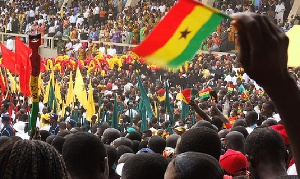Ghana is ranked 41st in the current Sydney-based Institute of Economics and Peace (IEP) 12th Global Peace Index (GPI) 2018, which ranked 163 independent states and territories according to their level of peacefulness.
Ghana placed fifth in the 44 log Sub-Saharan Africa (SSA) regional ranking with the best four spots being occupied by Mauritius, Botswana, Sierra Leone and Madagascar; that were equally ranked on the GPI respectively, as 20th, 29th, 35th and 38th.
Ghana, however, ranked 43rd in the 2017 GPI.
The bottom rankings in the SSA category were South Sudan, Somalia, DRC, Central African Republic and Nigeria.
In its report to the Ghana News Agency, the 2018 Global Peace Index showed that the world was less peaceful today than at any time in the last decade.
This report presented the most comprehensive data-driven analysis to-date on trends in peace, its economic value, and how to develop peaceful societies.
The GPI covered 99.7 per cent of the world’s population, using 23 qualitative and quantitative indicators from highly respected sources, and measured the state of peace using three thematic domains: the level of Societal Safety and Security; the extent of Ongoing Domestic and International Conflict; and the degree of Militarisation.
The results of the 2018 GPI found that the global level of peace had deteriorated by 0.27 per cent in the last year, marking the fourth successive year of deteriorations.
Ninety-two countries deteriorated, while 71 countries including Ghana improved.
The 2018 GPI revealed a world in which the tensions, conflicts, and crises that emerged in the past decade remained unresolved, especially in the Middle East, resulting in a gradual, sustained fall in peacefulness.
Six of the nine regions in the world deteriorated in the last year. The four most peaceful regions – Europe, North America, Asia-Pacific, and South America – all recorded deteriorations, with the largest overall deterioration occurring in South America, owing to falls in the Safety and Security domain, mainly due to increases in the incarceration rate and impact of terrorism.
Iceland remains the most peaceful country in the world, a position it has held since 2008. New Zealand, Austria, Portugal and Denmark also sit in the top five most peaceful rankings.
Syria remains the least peaceful country in the world, a position it has held for the past five years. Afghanistan, South Sudan, Iraq and Somalia comprise the remaining least peaceful countries.
Europe, the world’s most peaceful region, recorded deterioration for the third straight year. It deteriorated across all three GPI domains and eleven indicators, most notably on the intensity of internal conflict and relations with neighbouring countries.
For the first time in the history of the index, a Western European country experienced one of the five largest deteriorations, with Spain falling 10 places in the rankings to 30th, owing to internal political tensions and an increase in the impact of terrorism.
The ten-year trend in peacefulness found that global peacefulness has deteriorated by 2.38per cent since 2008, with 85 GPI countries recording deterioration, while 75 improved. The index has deteriorated for eight of the last eleven years, with the last improvement in peacefulness occurring in 2014.
The economic impact of violence on the global economy in 2017 was $14.76 trillion in purchasing power parity (PPP) terms. This figure is equivalent to 12.4per cent of the world’s economic activity (gross world product) or $1,988 for every person.
It noted that the economic impact of violence increased by two per cent during 2017due to a rise in the economic impact of conflict and increases in internal security spending, with the largest increases being in China, Russia and South Africa.
Since 2012, the economic impact of violence has increased by 16 per cent, corresponding with the start of the Syrian war and rising violence in the aftermath of the Arab Spring. The 2018 Global Peace Index uniquely revealed that peacefulness had a considerable impact on macroeconomic performance.
In the last 70 years, per capita growth has been three times higher in highly peaceful countries when compared to countries with low levels of peace. The difference was even stronger when looking at changes in peacefulness, with the report finding that per capita GDP growth had been seven times higher over the last decade in countries that improved in peacefulness versus those that deteriorated.
Peacefulness was also correlated with strong performance on a number of macroeconomic variables. Interest rates were lower and more stable in highly peaceful countries, as was the rate of inflation. A foreign direct investment was more than twice as high in highly peaceful countries.
In total, if the least peaceful countries had grown at the same rate as highly peaceful countries, the global economy would be almost 14 trillion dollars larger. Positive Peace improved 1.85 per cent on average between 2005 and 2013 but had stagnated in the last three years.
Despite improvements in most other pillars, acceptance of the rights of others has been deteriorating in Europe and North America since 2005. The region that experienced the most significant deteriorations across the highest number of Pillars was the Middle East and North Africa (MENA), followed by South America.
Low Levels of corruption, acceptance of the rights of others and well-functioning government were the key pillars that deteriorated prior to the largest deteriorations in internal peace. As a further testament to the relationship of macroeconomics and peace, improvements in positive peace were linked to strong domestic currencies.
A one per cent increase in positive peace was associated with a 0.9per cent appreciation of the domestic currency among non-OECD countries.
General News of Saturday, 9 June 2018
Source: ghananewsagency.org

















